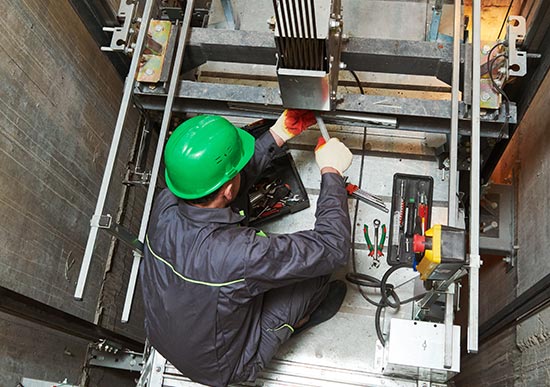Affordable Lift Maintenance Services in London: Top Lift Repair Companies Near Me
Affordable Lift Maintenance Services in London: Top Lift Repair Companies Near Me
Blog Article
Comprehensive Overview to Elevator Systems and Their Maintenance
Navigating the intricate globe of lift systems and their maintenance is a job that requires precision and expertise. From the different kinds of lift systems being used to the meticulous adherence to safety and security regulations, the upkeep of these upright transportation devices is a complex undertaking. As structures skyrocket greater and technology developments, the requirement for a comprehensive understanding of lift systems becomes significantly critical. Join us as we untangle the intricacies of lift upkeep, checking out typical problems, finest methods, and sophisticated technologies that form the contemporary landscape of vertical transportation.
Kinds Of Lift Equipments
Lift systems can be found in numerous kinds, each designed to match certain building needs and customer requirements. One of the most usual kinds consist of hydraulic elevators, traction elevators, machine-room-less lifts, and vacuum cleaner lifts. Hydraulic elevators are optimal for low-rise structures and make use of a hydraulic piston to relocate the lift vehicle. Traction lifts, on the various other hand, are extra suited for high-rise buildings and utilize steel ropes and weights to relocate the car. Machine-room-less elevators are a space-saving option as they do not need a separate maker space for the lift equipment. Vacuum cleaner elevators, a much more contemporary advancement, usage air stress differentials to relocate the auto within a clear tube.
Each kind of lift system has its own advantages and drawbacks, making it essential for building proprietors and programmers to meticulously consider their details demands before selecting the most appropriate choice. Elements such as building elevation, area accessibility, energy performance, and spending plan restrictions all play a significant duty in establishing the most effective elevator system for a certain structure.
Common Upkeep Problems
Normal upkeep of lift systems is crucial to ensure smooth procedure and lengthen their life expectancy. In spite of routine upkeep, elevator systems can still encounter usual upkeep concerns that need to be quickly addressed to avoid interruptions in service. Routine evaluations and positive maintenance can assist identify and fix these usual upkeep problems prior to they rise and influence the general performance of the elevator system.
Safety And Security Rules and Compliance
Following stringent safety laws and making certain conformity with industry criteria are extremely important for preserving the operational honesty of elevator systems. Lifts undergo an extensive collection of safety and security policies to protect guests, maintenance personnel, and the public. Regulatory bodies such as the Occupational Safety And Security and Health And Wellness Administration (OSHA) in the USA and the European Lift Association (ELA) in Europe develop guidelines that cover different aspects of lift design, installation, upkeep, and operation.
Conformity with these policies is not only a legal need however also a moral obligation for structure owners and elevator upkeep companies. Failure to fulfill safety criteria can result in fines, lawful liabilities, and, most notably, endanger the safety and security of individuals utilizing the lift. Regular assessments, upkeep checks, and adherence to safety procedures laid out in the regulations are important to ensure the risk-free and effective operation of elevator systems. By prioritizing Continued security laws and compliance, stakeholders can maintain the trust fund of the public and reduce possible risks related to elevator usage.
Best Practices for Upkeep

An additional important ideal technique is to without delay attend to any type of documented issues or unusual sounds to stop additional damage. Implementing an aggressive strategy to upkeep can save time and money in the lengthy run by staying clear of expensive repair work or replacements. Structure owners should additionally think about purchasing innovation upgrades to improve the efficiency and safety and security of their lift systems. By complying with these ideal methods, elevator systems can run smoothly and securely, supplying reliable upright transportation for owners.

Advanced Technologies for Effectiveness
Carrying out innovative technologies in lift systems can dramatically boost operational effectiveness and guest experience. These systems enable travelers to input their desired floor prior to entering the elevator, which after that guides them to the most reliable cars and truck.
Furthermore, the combination of clever sensing units and anticipating upkeep abilities has changed elevator maintenance. These sensors can find potential issues prior to they escalate, allowing proactive maintenance treatments and reducing downtime. In addition, the use of regenerative drives and energy-efficient components helps in reducing power usage and operating expense in elevator systems.
In addition, the application of cloud-based surveillance and remote diagnostics permits real-time tracking of lift efficiency and immediate troubleshooting of any type of breakdowns. This proactive method not just boosts system reliability however additionally enhances the general individual experience by ensuring nonstop and smooth lift operations.
Conclusion
To conclude, recognizing the various kinds of lift systems, typical upkeep concerns, safety regulations, finest upkeep methods, and progressed modern technologies for additional reading performance is important for making sure the smooth procedure of lifts. By adhering to security guidelines and carrying out ideal techniques for maintenance, structure proprietors can extend the life expectancy of their lift systems and make sure the safety and security of passengers. It is essential to remain upgraded on the latest advancements in elevator modern technology to boost performance and integrity.
The most typical types include hydraulic lifts, traction lifts, machine-room-less lifts, and vacuum elevators. Hydraulic elevators are ideal for low-rise structures and her comment is here make use of a hydraulic piston to relocate the elevator car. Machine-room-less lifts are a space-saving alternative as they do not need a separate device space for the elevator machinery. Normal assessments and positive upkeep can help recognize and solve these typical maintenance problems before they intensify and impact the overall efficiency of the lift system.

Report this page